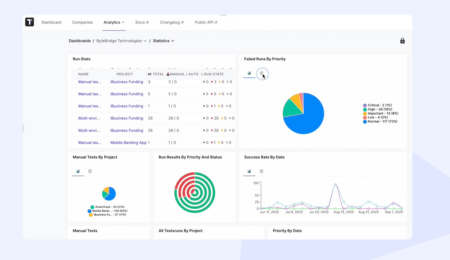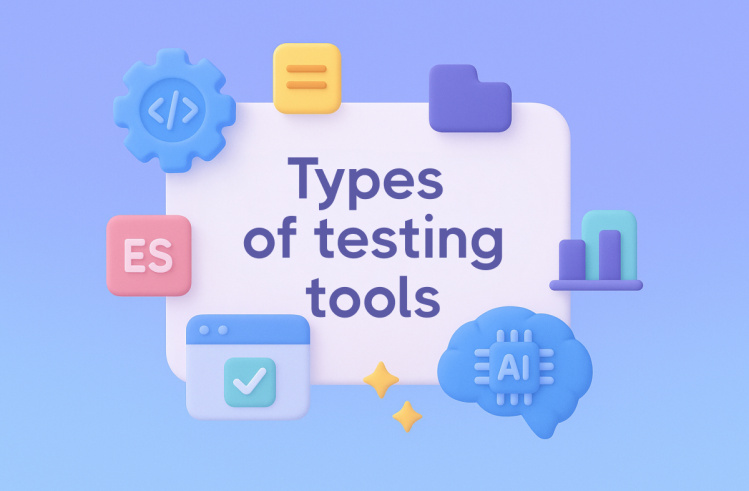The growing popularity of automated testing – running the tests without human intervention ensures faster releases without compromising software quality. Automated testing is a key aspect of the software development process. It ensures that regression testing, performance testing, exploratory testing etc., are executed effectively, with minimal risk of errors and maximum value of the final release.
If the software is not working correctly or does not adhere to quality standards, it can damage the company’s reputation as a reliable software provider, negatively impact customer satisfaction and the way end users perceive the product. That’s why establishing a well-managed quality assurance testing process is crucial for delivering high-quality products or services that meet initial software requirements.
Introducing a test management system for automated tests allows you to build more effective workflows. This helps you increase efficiency within the agile development lifecycle and solve complex testing issues. Once implemented properly, your business can start benefiting from improved test execution, boosting productivity and ensuring high product quality. Moreover, it opens up ample opportunities to enhance quality control, increase output, and improve the testing process in various ways. Keep reading to uncover more details below!
QA process: Meaning of the Concept
When it comes to software development, the quality assurance (QA) process is considered to be an extremely important element that runs along all stages of the software development lifecycle and checks whether a piece of software meets specified requirements or not.
If we refer to official sources, in ISTQB one can find the following definition of the QA process:
Part of quality management focuses on providing confidence that quality requirements will be fulfilled.

The QA process includes several stages:
- Definition of business requirements. What does the company want to achieve with the software product?
- Understanding end-user expectations. How should the application work to become competitive and in demand among the target audience?
- Creation of product specifications. What exactly needs to be tested (including both functional and non-functional aspects of the solution)?
- Development of test scripts and test suites. How can we verify that a specific part of the application behaves as expected?
- Providing feedback. How can the user experience be improved and costs reduced?
It helps test engineers to identify areas in the software solution that should be improved and optimized as well as enables them to test the final product. By collecting feedback from end users, they can make additional improvements based on their insights. If scheduled from the very start, QA teams can launch a software product that meets both business requirements and high standards with ease.
What are the Challenges of the Agile QA process?
Without a test management system in place, it is highly problematic for QA teams to perform fast and accurate testing activities to deliver a great piece of software. Moreover, they face many challenges when performing their day-to-day tasks. Let’s take a closer look at some of those issues that they encounter:

- Miscommunication in the team: Lack of clarity over tasks makes collaboration and effective communication difficult among development and QA teams. Moreover, the inability to keep them fully informed on important changes and provide them with correct information increases unproductivity and has a damaging impact on the future release.
- Lack of automation testing: It’s no secret that the testing process takes a long time if done manually. Having that in mind, failing to accommodate automated testing in this process contributes to spending a lot of time on running tests as well as fixing potential issues after the release.
- Scattered data: Not maintaining identical data across multiple systems leads to business-critical mistakes. Team members are forced to input data manually in different systems, which makes this process tedious and time-consuming. This can result in poor decisions, inaccurate reports, and a lack of clarity during the requirements analysis phase.
- Lack of testing strategy: Without a testing strategy in the form of a proper test plan, the team doesn’t have a clear picture of the project. Moreover, it’s impossible to create a thought process that helps to structure the QA activities, keep every team member informed, and discover some unexpected issues, including logical gaps, software requirements that aren’t being met, etc.
- Poor requirements and scattered data: Dealing with poorly-written documentation leads to misunderstandings when interpreting requirements, which can lead to test code errors and delays and uncertainty regarding the QA process. Moreover, it results in more work to be done and more bugs to be fixed. QA professionals must ensure that testing requirements are specific and well-polished to avoid mistakes and save valuable time.
As you can see, without various tools designed to streamline testing activities, businesses can run themselves ragged trying to keep up. This highlights the importance of a test management system for automated tests, which is crucial to improving the QA testing process.
Many companies use just testing tools and don’t realize the value of having a test management system at hand. However, it can significantly support the quality assurance testing process and help you deliver software that meets high standards. Here we are going to outline why you need to opt for automated testing:
- Effective organization of project documentation. Just imagine. You have project documentation, but its use is extremely problematic. Why? Poor structuring, different formats, complex technical language. There can be many reasons. By using a TMS, you will be able to structure the project documentation. This will make it accessible and visible to all stakeholders: the development team, business analysts, project managers, and quality control groups. Literally, to everyone working on creating a digital solution. This approach guarantees clear interaction and coordination of all work processes.
- Optimized collaboration within the team. Specialized software helps streamline collaboration on test planning, designing manual or automated tests, and executing them effectively. With a TMS, teamwork on your project becomes a reality.
- Combining manual and automated testing. Do you bet on test automation? Do you include manual tests in your QA processes? The Test Management System provides a unified platform for working with both. You can run any tests together in real-time. This improves collaboration on the project, allows for quick results, and lets you fix any issues discovered. Another clear advantage is the ability to quickly convert manual tests into automated ones. This expands test coverage, speeds up testing, and reduces the need for manual effort.
- Access to deep analytics and advanced reporting. Without a TMS, the team may need external reporting tools. In most cases, this requires additional time for training and leads to unplanned budget expansion. Specialized systems typically offer users built-in reporting and customizable dashboards for detailed test analytics.
- Improved team management. If you are still manually assigning tasks to team members, it’s time to automate this process. A TMS allows you to do this with just a few clicks. In the future, you can also prioritize tasks and track the status of each. This ensures that nothing important will be overlooked. Has the project’s focus changed, and it’s necessary to redistribute tasks to guide the team in a new direction? This is also not a problem. You can be sure that all specialists are not overloaded and are working on the scope of testing that truly matters at this moment. Moreover, this approach to team management reduces overhead and allows managers to focus on more global issues.
- Simple tracking of progress and performance. During the test execution phase, it’s important to monitor the process’s progress. With a quality Test Management System, this can be done in real-time, making adjustments as needed. Such platforms offer dashboards. What can be seen with their help? Testers can access information on the number of tests completed, defects found, etc. They can also ensure that testing is going according to the planned schedule. Thanks to TMS, the team can identify bottlenecks in the QA process, determine areas for improvement, and fix anything that is not going according to plan.
- Involving non-technical specialists in testing. With a TMS, all stakeholders, including those without specialized knowledge (PM, BA, etc.), can participate in the quality assurance of the software product.
How is this possible? The fact is that these platforms simplify the process of performing tests. You can launch testing with a single click. No deep technical knowledge is required.
Moreover, test results are generated in an understandable format. As a result, all team members can review and interpret them. This means testing becomes completely transparent for all stakeholders.
Why do you need Test Management System for automated tests?
Many companies don’t have a test management system at hand. Moreover, they don’t realize that it can support the QA process and help you deliver a great piece of software that meets high standards. Here we are going to outline why you need to opt for automated testing:
- This helps structure project documentation and make it visible for all parties involved, including stakeholders, development teams, BAs, PMs, QA teams, etc.
- This helps work together on producing and implementing a testing strategy as well as carrying out manual or automated tests.
- This helps view test results and provides test analytics for all technical and non-technical team members.
- This helps assign test tasks and manage these tests with a simple click.
- This helps you evaluate progress and productivity during the software testing process.
- This helps keep manual tests along with automated ones in one system. If you need to meet a precise requirement to reach the optimum test coverage, you can convert manual tests into automated ones with ease.
- This helps non-technical team members support automated testing by carrying out automated tests and viewing their results.
Want to improve QA process?
With Testomat.io, you can better plan and manage your testing activities and foster collaboration among the teams to speed up the entire development process, resulting in higher user satisfaction and more robust products.
👉 Top 5 Improvements
Test Management System provides for Software QA process
In fact, a test management system is a critical asset for your QA process that multiplies the resources of your software engineers. Let’s move on to improvements that the test management system provides for the QA process.
#1: Agile-driven workflow
Managing remote teams becomes more effective by incorporating a test management system. Using correct and real-time data allows team members to eliminate data duplication and prevent them from costly mistakes. Moreover, it allows for seamless collaboration across agile methodologies. Because you’ll be able to connect stakeholders, BAs, PMs, Dev, and QA teams. This fosters communication and ensures regular updates on the QA testing process.
#2: Better team management for a Great QA Process in Software Testing
With a test management system in place, the whole team can participate in the testing process. When working on a testing project, you can organize project dashboards, design manual or automated tests, and manage users and roles. In addition to that, you can better coordinate and monitor the activities of your team members, view deadlines, track tasks and their completion. This improves coordination and monitoring of the QA testing process, tracks deadlines, and ensures task completion. As a result, QA professionals are better equipped to manage project workflows of various tasks and assignments that increase team productivity and efficiency.
#3: QA process Improvement
Only by opting for a test management system can companies establish an optimized quality assurance process. It enables the creation of comprehensive quality assurance plans by integrating both manual testing and automated testing capabilities. The system also includes built-in auto-suggestion features to streamline test case creation. In addition to that, you can add tests in bulk, use drag & drop mode or test attachments during test case creation. This will increase the test automation rate, reduce the number of missed bugs, and shorten the testing time.
#4: Data consolidation for Software QA Testing Process
Having a test management tool in place allows engineers to deal with the information delivered from different data sources, including a variety of testing frameworks, knowledge base software, popular CI\CD tools, ticket management tools, etc. It helps them create and run test cases quickly and easily as well as better plan and execute the tests. Moreover, they can set up milestones and requirements. All these can be done from one place removing any redundancies and cleaning up any errors. This significantly streamlines the development and QA processes as well as makes them more manageable.
#5: Sophisticated reporting & analytics for QA Process in Agile

With a test management solution in place, you can better monitor the testing activities as well as establish common testing KPIs and metrics. It helps you make sure the project is running as it should, on time, and on budget and allows you to make any changes in configuration to track exactly what you need. In addition to that, you can visualize the real-time progress of the tests and share it with stakeholders and the management team. It provides stakeholders with timely updates on project status, they can be notified about finished runs via email, Slack, MS Teams, or Jira.
Report ensures that final release goals align with the project budget and timeline. Additionally, real-time progress visualizations keep everyone informed, including individual testers and test managers.
Bottom Line: Want to arm your team with test management software?
Technological advances are changing not only the world but the software testing process as well. Without implementing best practices of the QA process organization, the stream of new clients dries up, putting the whole testing process in jeopardy. With test management tools like testomat.io, you can streamline your testing process, foster better team collaboration, and significantly improve your software quality assurance. These systems enable you to quickly adapt to changes, implement new features, and accelerate the development process while ensuring the highest standards of user experience and product quality.








